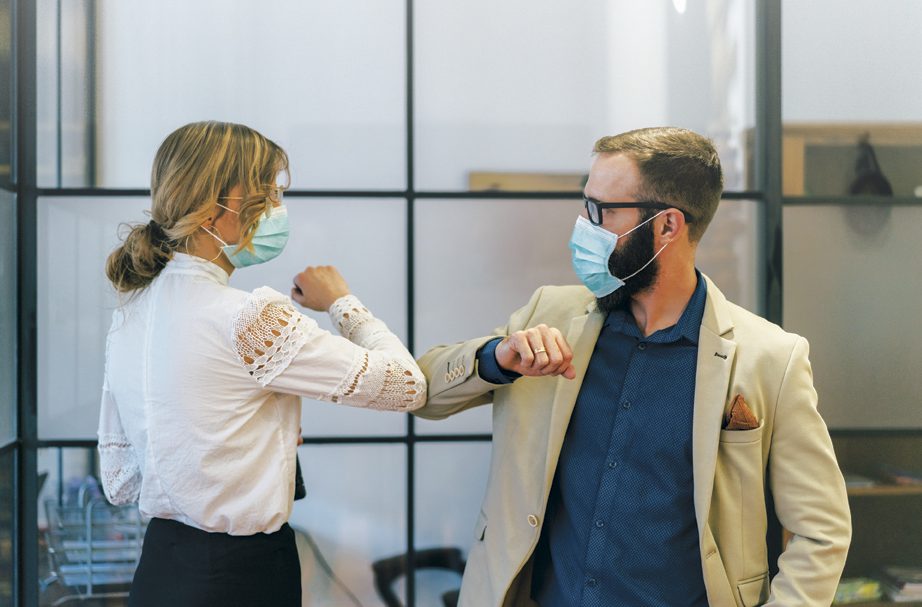CULTURE OF SAFETY
Guiding your insureds through the pandemic and beyond
By Christina Johnson
Addressing the unique safety issues associated with COVID-19 has been a challenge for employers.
It’s a struggle to keep up with the constantly evolving guidelines issued by the Centers for Disease Control and Prevention (CDC); the Occupational Safety and Health Administration (OSHA); and federal, state, and local governments. Having unplanned employee leave results in a loss of productivity. There are unbudgeted costs for personal protective equipment (PPE), hand sanitizing and washing stations, training, testing for symptoms, and monitoring for safety compliance.
Though we can empathize with employers, the fact remains that they are responsible for maintaining a safe and healthy workplace. Employers must keep staff informed, which should ultimately help keep COVID-19 cases to a minimum. Helping prevent the spread of the virus is critical for worker health and the health of the communities in which they operate. Taking steps to prevent the spread of the disease could also help mitigate the additional operational, regulatory, and legal risks associated with the pandemic.
Keeping up with all of the ever-changing safety rules and regulations can be a monumental task, one that may require partnering with another organization to help you stay current and keep your insureds compliant.
In this article, I dive into what a culture of safety is and how to make the case to your commercial insureds that instilling such a culture is vital to their self-preservation.
What is a culture of safety?
A culture of safety starts with comprehensive and consistent communication. There are three specific tactics employers can use:
- Implement training in their onboarding process. Employees should know and understand what’s expected of them on the job from day one. New-hire training should cover safety policies and procedures. Training topics that can help drive home an employer’s focus on safety are PPE awareness; basic housekeeping; slips, trips, and falls; and first-aid awareness. Employees should also be trained on the process to follow when an accident or incident occurs, which ensures they understand their responsibility to report it to management in a timely manner.
In regard to COVID-19, employees need to know which PPE is required, who will provide it and how to use it. They need to know their risk of catching the virus and how to help prevent its spread. Employees should fully understand the employer’s policy for reporting exposure to COVID-19 and any safety violations to management. Additionally, staff need to understand the consequences for not reporting COVID-19 exposure or any other safety issue, accident, or incident in a timely manner.
The bottom line is that employees should know how to address all workplace safety risks before starting work.
- Provide ongoing messaging.
Most employers fall short when it comes to providing regular communication about the importance of workplace safety. Employers can and should use every opportunity—team meetings, manager meetings, all-staff meetings, memos, and training sessions—to reinforce current safety best practices. For COVID-19, that means repeated messages about how to properly use PPE and maintain social distancing.
To accomplish the goal of ongoing and consistent messaging, some employers hold weekly safety briefings. For example, a manufacturing facility might hold a briefing at the start of a shift once per week. Some employers hold a more formal monthly safety committee meeting, where representatives of different departments come together to talk about the safety issues they face and how to address them. Then they communicate their findings and recommendations to employees and management.
A critical step that employers often forget is enforcement of policies. If an employee does not follow established policies and procedures, management should take action. Depending on the severity of the infraction, the consequence could range from a write-up to termination. Enforcement is essential to further instill a culture of safety. Turning a blind eye sends the wrong message to employees.
- Equip staff with proper PPE.
The right PPE is a necessity for any job, but COVID-19 has made us all painfully aware of its importance in preventing the spread of communicable diseases. In the Risk Management Center, we have observed a higher number of COVID-19 cases for employers who do not provide PPE for employees or defer responsibility to employees to provide their own PPE.
What constitutes as proper PPE depends on the type of establishment. Here are some examples of the measures that safety-conscious employers have taken:
- Plexiglas shields between workers, or between workers and customers
- Markings on floors to keep customers socially distanced
- A limit on the number of customers in the store
- Gloves for servers and other workers who are in constant contact with customers
- Face shields that provide more protection than a mask
- Reminder announcements regarding social distancing
- Temperature checks
- Questionnaires to determine if workers or customers have COVID-19 symptoms
- Contact tracing
How you can help your insureds
There are three impactful ways that you can help your insureds maintain a culture of safety in the workplace during the pandemic and beyond:
- Teach them about safety. In your newsletters and other routine communications with your insureds, define a culture of safety. Use specific examples from their industry when possible. You don’t want to motivate them through fear, but you can help them understand the potential operational and legal risks in relation to violations of COVID-19 safety regulations. The highest risks are, of course, going out of business and loss of life.
While the threat of fines and lawsuits is something employers should consider, it’s more important to help them focus on keeping the business operational and profitable. What we’ve seen in the Risk Management Center is that the more proactive employers are about safety, the more productive and efficient they are.
We all need to work together to keep employees healthy and working and businesses up and running. You can do your part by sending frequent and consistent messages about what a culture of safety looks like and why it’s important to maintain it—even though we’re all experiencing pandemic fatigue.
- Give them tools to keep staff safe. To the extent possible, give your insureds the resources and tools they need to run a successful safety program. Tell them where they can find training specific to COVID-19 and safety hazards specific to their industry. Insureds can also benefit from samples of safety policies, employee newsletter articles and safety briefings.
Focus on specifics about what is working in terms of proper PPE and the spread of disease in the workplace. Give them examples cited by industry-specific organizations or share intel from your other insureds so they can better understand what works and what to avoid.
- Help them comply with regulations. Employers look to you for guidance on how to comply with regulations. They’re confused, and rightfully so. Local, state, and federal laws are changing quickly and often conflict with each other and OSHA and CDC guidelines. Keeping up with all of the ever-changing safety rules and regulations can be a monumental task, one that may require partnering with another organization to help you stay current and keep your insureds compliant.
Culture and the bottom line
Though your commercial insureds have been put through the wringer when it comes to COVID-19 safety, the associated increased awareness of workplace safety may have some positive outcomes. For one thing, employers are protecting their employees in a way that prevents the spread of the virus and other communicable diseases. Employers are much more knowledgeable and serious about how easily disease can spread. They are also much more likely to support employees who need to take sick leave.
Instilling a culture of safety at your commercial insureds isn’t only good for employees’ health, it’s good for business. The fewer workplace accidents you have, the fewer sick days staff will need to take—not to mention the lawsuits you could potentially avoid.
 The author
The author
Christina Johnson is the senior client success manager for KPA’s Risk Management Center, where she counsels employers in multiple industries about how to address workplace safety and risk. She also works closely with insurance brokers who seek advice about how to help their commercial insureds manage risk. She has been with KPA for six years, where she has also worked as an HR consultant, having more than 20 years of HR experience. You can reach Christina at cjohnson@kpa.io; visit www.kpa.io for more information.





